2020 DWNS ICR APPENDIX D (revised 12-2-20)
2020 DWNS ICR APPENDIX D (revised 12-2-20).docx
2020 Drinking Water Infrastructure Needs Survey and Assessment (NEW)
2020 DWNS ICR APPENDIX D (revised 12-2-20)
OMB: 2040-0302
Appendix D – Comments and Response to Comments Received on the First Federal Register Notice
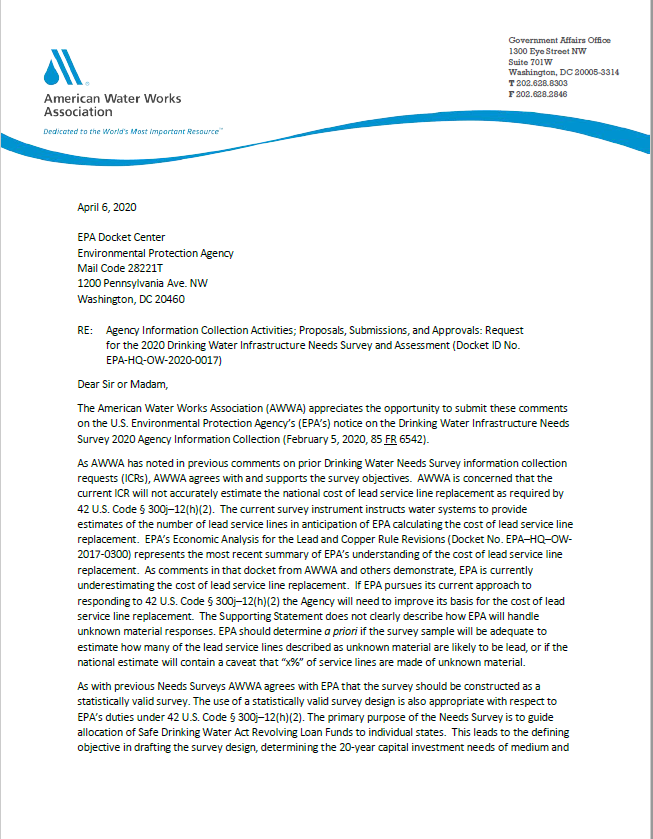

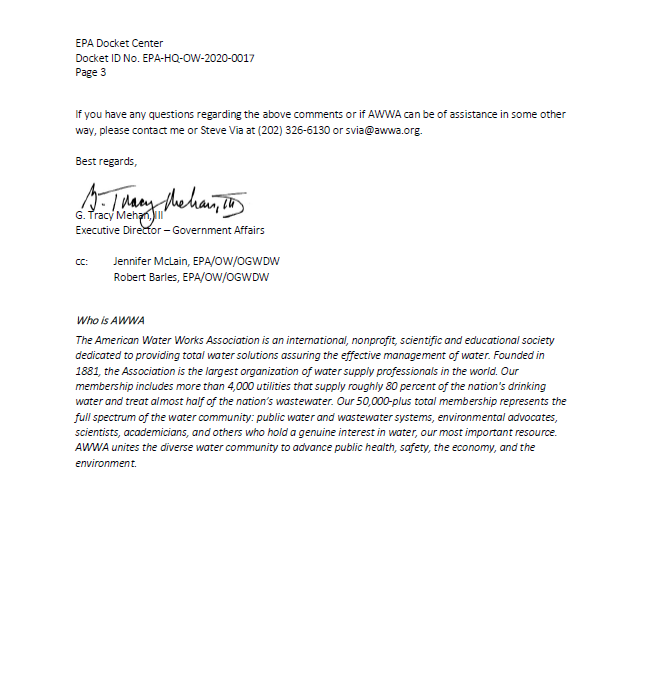
EPA Response to Comments Received from the American Water Works Association (AWWA) Regarding the 2020 DWINSA
Below is a summary of the April 6, 2020, comments received from the AWWA regarding the Draft Information Collection Request for the 2020 DWINSA and EPA response to each comment.
AWWA expressed concern that the current ICR does not accurately estimate the national cost of lead service line replacement as required by 42 U.S. Code §300j-12(h)(2). More specifically, AWWA is concerned that EPA is underestimating the cost of lead service line replacement in the Economic Analysis for the Lead and Copper Rule Revisions (Docket No. EPA–HQ–OW-2017-0300) and EPA will use that approach to estimate costs for lead service line replacements reported in the DWINSA.
EPA will update DWINSA lead service line replacement cost models to the extent possible. Cost data to develop the models is anticipated to be available from DWINSA respondents, data used for the Economic Analysis for the Lead and Copper Rule Revisions, and state datasets. EPA acknowledges there will be a limitation on the accuracy of the cost estimate developed because information on the length of each service line and site-specific construction hindrances are not being collected. For the DWINSA, EPA will estimate an average replacement cost per service line and apply that cost to the number of lead service line replacements identified. EPA will provide details of assumptions used for the cost estimates in the report, including how the estimates account for utility- and customer-shared responsibility for replacement costs.
AWWA expressed concern that the supporting statement does not clearly describe how EPA will handle responses for unknown service line materials. AWWA requests EPA determine if the survey sample is adequate to estimate how many lead services lines described as unknown material are likely to be lead and how that information will be presented in the findings.
AWWA stated that it is not clear that the current supporting statement has been updated for the changes in the number of systems in the United States by size category and system type.
EPA has updated the number of systems in the United States by system size and category for the 2020 DWINSA. This updated frame was used for the 2020 DWINSA ICR issued for the initial public comment period and this ICR. The inventory frame was updated using final system inventory information from the 2015 State DWINSA, the July 2019 SDWIS freeze, and review and correction of the frame by the state and EPA regional coordinators. Review of the frame by the coordinators focused on the type of source water used (ground water, surface water, or purchased finished water) and the population served. The 2015 DWINSA Frame was provided to the state and EPA regional coordinators as a reference during their review to improve the efficiency of the process. It is important to note the population served by systems in the DWINSA frame includes consecutive system populations, which may differ from the population reported for the systems in the Safe Drinking Water Information System (SDWIS). This approach is applied to the DWINSA because it has been found to be a better representation of infrastructure size. For example, wholesale suppliers of finished water that serve consecutive populations of more than 100,000 persons may be in SDWIS as systems serving only the very small population at the treatment facility. The 20-year infrastructure needs of these systems would be more representative of a large system than of a small system that serves 500 or fewer persons.
AWWA pointed out that the survey design description assumes more systems serving more than 100,000 persons will be included in the survey sample than exist and the number of medium-sized systems in the supporting statement does not align with current publicly available community water system counts.
As explained in the previous comment response regarding updating the 2020 DWINSA frame, EPA includes total population served, including consecutive systems, for the DWINSA. This differs from other definitions of population served and increases the number of systems serving more than 100,000 persons in the frame. This population definition also adjusts the number of medium systems when compared to SDWIS. In addition, the frame validation process combines some systems listed in SDWIS into one system for the DWINSA, resulting in fewer systems in the DWINSA frame. An example of combining systems for the DWINSA would be including two or more systems identified in SDWIS that have different Public Water System Identification Numbers (PWSIDs) because they represent infrastructure (such as treatment facilities and distribution systems) that are the responsibility of the same entity and are addressed by the same budget and planning programs.
AWWA expressed concern that the statistical validity of the sampling methodology is stated but not demonstrated in the supporting statement. At present, the Agency’s approach utilizes a sample of 3,912 water systems to estimate the 20-year capital expenditure needs of approximately 50,000 community water systems and more than 12,000 not-for-profit non-transient noncommunity water systems.
There are two primary purposes of the DWINSA: to provide a national-level estimate of infrastructure investment needs and to estimate the relative level of states’ needs and EPA Region needs (for the American Indian and Alaska Native Village water systems) for use as the basis for the DWSRF allotment formula. The DWINSA must be implemented within the context of a reasonable budget to undertake the effort for those two purposes.
The goal of the sampling plan is to collect information about future investment needs from a representative and unbiased sample of public water systems. The 2020 DWINSA also will collect information about service lines, operator workforce, and iron and steel construction materials. The sample is randomly selected, which ensures that it is representative and unbiased. Algorithms that have been tested, validated, and published are used to select the random samples. A stratified random sample is used to capture the diverse needs of public water systems. Systems are divided into several categories, and the sampling approach selected for each maximizes the data quality objectives of the survey while remaining within the survey’s budget. The approach has been peer-reviewed and is fully documented in Part B of the supporting documentation. In summary:
State-regulated community water systems serving more than 100,000 persons (“large” systems). These systems serve a very large share the nation’s population and account for much of each state’s and the nation’s drinking water infrastructure investment needs. Therefore, the survey conducts a census of these systems; they are all included in the survey.
State-regulated community water systems serving 3,301 to 100,000 persons (“medium” systems). Stratified random samples of medium-sized systems are selected in each state that chooses to fully participate in the survey. The systems are divided among categories based on their water source and the size of the population they serve. The sample is selected randomly, which ensures it is representative of each state’s medium systems. The medium- and large-system sample is designed to estimate the need for each state with a 95 percent confidence interval of plus or minus 10 percent of the state’s need. The sample is relatively large because of the large variance in system need.
State-regulated community water systems serving fewer than 3,300 persons (“small” systems). Small systems account for a very small share of the need of each state and the nation; therefore, they have not been included in all DWINSA’s. The 2020 DWINSA uses a national stratified random sample of these systems. The sample is stratified by water source and population-served categories. To minimize the burden on small systems, site visitors will collect the data. The budget allows for approximately 60 systems to be visited. The sample is allocated among the strata to provide the highest level of precision given the sample budget. As with medium systems, the sample is selected randomly, which ensures it is representative of small systems nationally.
State-regulated not-for-profit non-community water systems. Noncommunity water systems have not been survey since the 1999 assessment. All not-for-profit non-community water systems serving more than 10,000 persons will be included. A national random sample of small (serving fewer than 10,001 persons) not-for-profit non-community water systems will be surveyed. The sample is selected randomly to ensure it is representative. While there are many noncommunity water systems, the 1999 survey demonstrated that they account for a very small share of the national need. Because it is random, the small sample will provide an unbiased estimate that is representative of not-for-profit non-community systems.
American Indian (AI) and Alaska Native Village (ANV) systems. These systems are regulated by EPA Regions. Stratified random samples of each are taken. The systems are stratified by water source and population-served categories. A census of all systems serving more than 3,300 is also taken. As with state-regulated systems, the smaller system sample is selected randomly, which ensures it is representative of small systems nationally. The samples are designed to estimate AI and ANV needs with a 95 percent confidence interval of plus or minus 10 percent.
AWWA states that the ICR appears to underestimate the time and effort required to prepare a survey response. AWWA asserts that the burden estimate should assume all systems are completing the Needs Survey for the first time. AWWA also expressed doubts that the survey can be completed by most participants in the time described.
The DWINSA relies on coordinators for the state, Navajo Nation, and EPA regional offices to provide considerable support to medium and large systems in the state survey and to the Native American DWINSA respondents. These coordinators attend two-day training sessions and have access to refresher webinars and resources, and to the technical support provided by the EPA National DWINSA Coordinator and contractor. EPA provides specifically-trained drinking water system experts to help assess the needs for small systems with input from the system representatives. This use of trained coordinators and site visitors ensures data collection efforts are efficient and effective and reduces the burden on water systems for understanding the DWINSA policies and procedures and how to complete the survey instrument. Because of this approach, the list of items AWWA notes as responsibilities of the system for survey response are shared with the trained coordinators and site visitors.
As an additional effort to reduce burden, EPA provides the final 2015 DWINSA projects for the State DWINSA and the final 2011 DWINSA projects for the Native American DWINSA as information pre-populated onto the 2020 questionnaires. This provides a significant starting point for the over 75 percent of the systems that are in the 2020 DWINSA and also responded to the previous survey. Use of the modified panel approach for the 2015 State DWINSA demonstrated, through comments by state coordinators, that significantly less time was needed to complete the survey responses for systems that responded to the 2011 DWINSA than those that did not. The state coordinators conveyed this was particularly true when the previous survey submittal used the infrastructure inventory approach to thoroughly capture the systems’ infrastructure assets. EPA encourages the inventory approach for identifying projects for all survey respondents and the vast majority of survey responses use this approach. The inventory approach and pre-population of survey project tables also assists water system respondents that are not familiar with the previous DWINSA.
Based on these burden-reducing efforts, EPA believes assumptions included in this ICR on the time anticipated for survey completion are valid and that the schedule for submitting the surveys is reasonable. In addition, the AWWA comment cites 2.15 hours as the estimated average burden for survey completion. As described in section A.6 and shown in Exhibits A-6-16 and A-6-17, the estimated average unit burden for respondents ranges from 7.58 hours for fully participating community water systems serving more than 50,000 persons to 2.00 hours for state NPNCWS serving 10,000 and fewer persons. Systems in partially participating states that are asked to only respond to the OpW and LSL categories of questions are estimated to have an average unit burden of 1.05 hours per system.
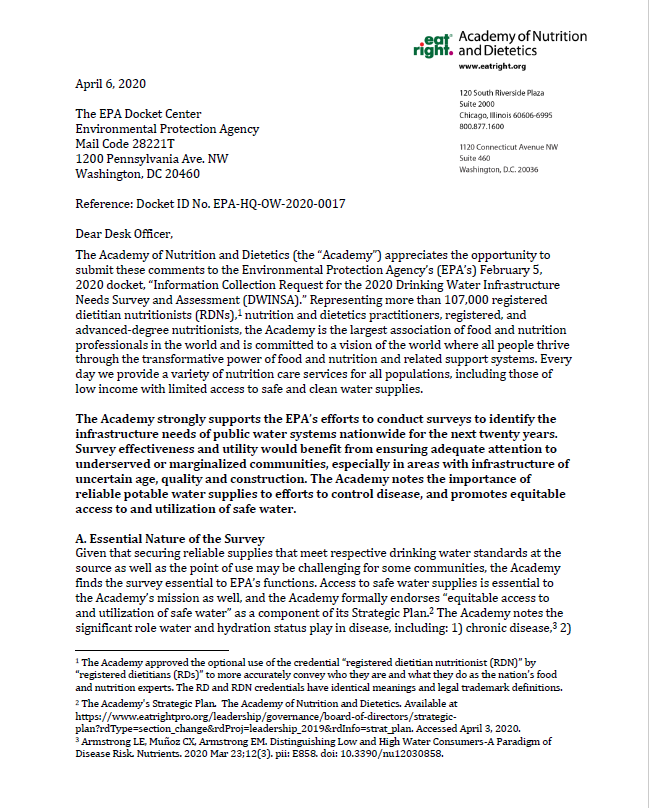


EPA Response to Comments Received from The Academy of Nutrition and Dietetics (the Academy) Regarding the 2020 DWINSA
Below is a summary of the comments received April 6, 2020, from the Academy regarding the Draft Information Collection Request for the 2020 DWINSA and EPA response to each comment.
The Academy suggests expansion of the survey to include a representative sample of lower socioeconomic status households across the country. The Academy suggests survey effectiveness and utility would benefit from ensuring adequate attention to underserved or marginalized communities, especially in areas with infrastructure of uncertain age, quality and construction.
The DWINSA does not stratify the sample by socioeconomic criteria. This would increase the sample size and introduce resource issues for completion of the survey. The DWINSA captures some of this information indirectly through the national survey of small systems and through the statistical approach of the state and separate AI and ANV Native American surveys, but not as a targeted sample.
The Academy of Nutrition and Dietetics suggests the addition of the following content to the state and tribal DWINSA surveys:
In “Source, Treatment, Storage, and Pumping Inventory,” include “Truck or other means of delivery by vehicle from remote location” as a source option.
The DWINSA includes water-haul vehicles that are utility-owned as infrastructure needs. DWINSA coordinator training describes these needs as allowable. Based on this comment from the Academy, EPA added water haul vehicles to the Needs Evaluation Guide – a worksheet resource recommended for use by states, EPA regional offices, the Navajo Nation, and small system site visitors when discussing potential DWINSA projects with utilities. EPA also added water haul vehicles to the “Source, Treatment, and Pumping Inventory” as suggested. Water haul vehicles are reported as “Other” types of need using Type of Need code W10.
In “Transmission and Distribution Inventory,” include a specific option for pipe of unknown materials. Consider adding an option of “unknown” for “% of this category/size pipe in poor condition” for each category of pipe of known material.
To accommodate changes to the I&S category of questions that EPA identified since the ICR supporting statement was prepared for the initial 60-day public comment, the “Transmission and Distribution Inventory” page has been revised to the “Pipe and Storage Inventory.” The revisions added an option for "unknown" pipe materials for future replacements. These revisions eliminated the existing pipe inventory information, which was rarely competed by survey respondents. EPA does not include the inventory information in the DWINSA database. The inventory table was intended to assist with identification of the infrastructure inventory to prompt discussion of potential projects. (e.g., The PVC/HDPE is in good condition, but the cast iron pipe that is larger than 24-inch diameter is in poor condition).
Add a question: “In what way is the system known to not be in compliance with EPA drinking water standards? What repairs/upgrades are required to ensure compliance? What are estimated costs of these repairs/upgrades?”
Project codes capture information on 20-year infrastructure needs that are directly related to SDWA regulations. Obtaining or maintaining compliance through additional treatment, treatment facility rehabilitation, replacement of deteriorated pipe, and other projects is inherent to reported needs because the DWINSA captures projects that are in furtherance of the public health objectives of the Safe Drinking Water Act. However, to meet the primary purpose of the DWINSA to obtain a full accounting of all infrastructure needs at the national and individual state levels, EPA is careful to avoid any implied or assumed connection of the DWINSA to reporting or compiling compliance issues that might cause hesitation by a respondent to provide a complete accounting of needs.
Add a question: “Is the community system able to supply all households and businesses within the designated town/city boundary? If not, why not?” Provide answer options, such as: distance, geology, lack of clear right-of-way, and other options as may be prudent.
Projects to extend water from public water systems to homes that currently have an inadequate quality or quantity of water are included in the DWINSA. DWINSA training and reference materials address these potential needs. Providing service to homes that already have adequate drinking water is not a DWSRF-eligible project; therefore, these service extensions are not included in the DWINSA.
Add a question: “Are there known or suspected risks to the quality of the community supply from any of the following: municipal or private landfills, hazardous waste sites or brownfields, farms or meat processing plants, industrial plants, mines or mine drainage ponds or lagoons, construction sites, private property containing miscellaneous hazards, other?”
In-depth consideration of the sources and risks of water supply contamination is strongly encouraged by EPA to be included in every system’s source water assessment and protection plan. As with developing a system’s asset management plan, the gathering of such information is outside the direct scope of the DWINSA effort. However, both types of assessments and plans can provide documentation to demonstrate a project’s necessity, feasibility, and commitment in order to be accepted as an infrastructure need by the DWINSA. To the extent possible, EPA will analyze DWINSA data and supporting documentation of submitted projects to further understand contamination risks and concerns the projects are intending to address.
Add a question: “Are there known or suspected risks to the quantity of the community supply from any of the following: falling groundwater table, falling reservoir level or depleted surface flow, and is this change due to altered geology, lack of precipitation, or other cause, known or unknown?”
Similar to the EPA recommendation that each water system have up-to-date source water assessments and asset management plans, each water system is also recommended to have a risk and resilience assessment and an emergency response plan. While the DWINSA
does not directly gather information on the risks to water systems, all of these water system assessments and plans can help provide the documentation to demonstrate a project’s necessity, feasibility, and commitment in order to be accepted as an infrastructure need by the DWINSA. To the extent possible, EPA will analyze DWINSA data and supporting documentation of submitted projects to further understand contamination risks and concerns the projects are intending to address.
Add a question to be provided to low-income households: “Do you drink your household water? If not, why not? Please check all that apply: taste concerns (add explanation), health concerns (add explanation), visual concerns (add explanation), lack of supply due to: costs to install private line from public connection, lack of plumbing or fixtures in house, repairs to existing plumbing not affordable, unresolved landlord-tenant issues.”
Households are not surveyed by DWINSA. The respondents are the public water systems.
Add a question: “Of those residents who don’t consume their household water, how many consume water from another site in the community (i.e., the same supply)?”
Households are not surveyed by DWINSA. The respondents are the public water systems.
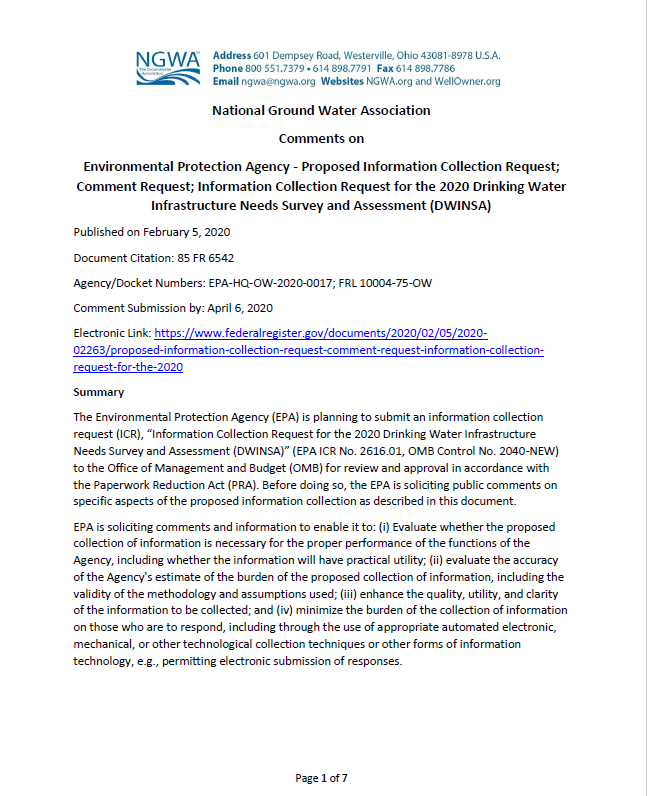

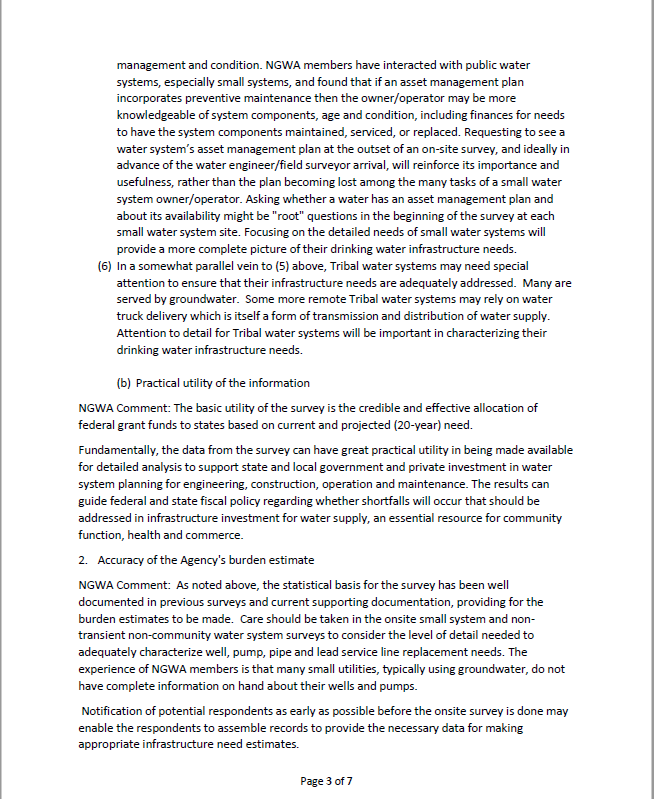
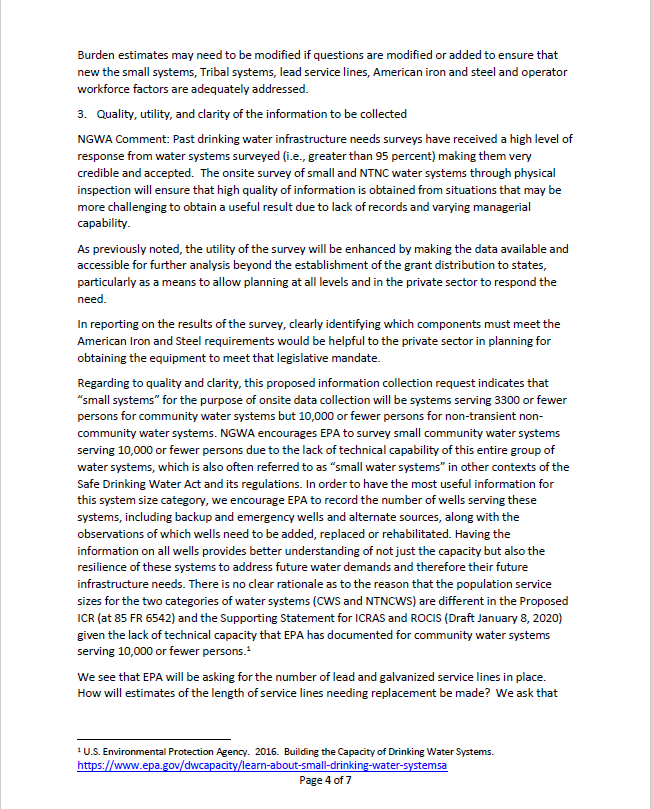
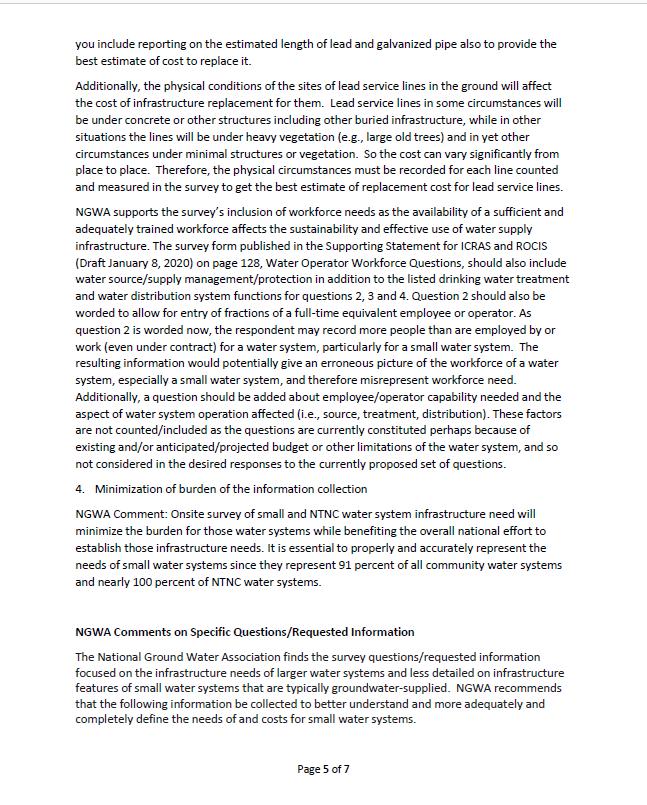


EPA Response to Comments Received from the National Ground Water Association (NGWA) regarding the 2020 DWINSA
Below is a summary of the April 6, 2020, comments received from the NGWA regarding the Draft Information Collection Request for the 2020 DWINSA and EPA response to each comment.
NGWA listed aspects of drinking water system infrastructure need that should be included and for which it is not clear to NGWA if they are included in this survey:
Large subsurface reservoir and associated infrastructure need of water districts that recharge aquifers from which public water systems draw water for their customers. These subsurface reservoirs are often referred to as “managed aquifer recharge” projects or sites. This water source need exists particularly in the western United States and should be included in the Needs Survey. Adding these water district water sources may add to the number of respondents.
Aquifer recharge and recovery wells are allowable for the DWINSA if they are the responsibility of a public water system selected to participate in the DWINSA. A water district with such a subsurface water resource would be included in the frame (inventory) for the DWINSA and therefore could be selected to participate if the district has a Public Water Supply Identification Number (PWSID). If the entity responsible for the water resource is not a regulated PWS, it is considered a provider of raw water and those infrastructure costs would be beyond the scope of the DWINSA. Thus, the number of DWINSA respondents would not change.
Alternate, back up and emergency water supply to maintain water system resilience and provide sustainable water supply in emergency and disaster circumstances. This water source need exists across the country and should be incorporated in the Needs Survey. Surveying this need may add to the burden of water systems already counted in the survey design as potentially being respondents.
Alternate, back-up, and emergency water supplies are included in the DWINSA if they address a source water quantity concern faced by current customers. These types of need would be reported as new wells, new intake structures, or other types of new sources of water. The burden of including these needs are already addressed by the burden estimate.
Green infrastructure projects that may reduce and/or delay need for expanding capital outlays should be identified and tracked over time to determine their advantages for mitigating water system capital needs in the face of expanding traditional infrastructure.
Green infrastructure is included in the DWINSA. However, tracking which projects are green and their advantages over time is outside the scope of the DWINSA.
The emphasis of the survey seems focused on treatment and distribution and on larger water systems and less so on water source, wells, springs and workforce for small systems. For small systems, the well(s) and pump(s) are major infrastructure components needing greater attention to more detailed information to obtain appropriate and credible results. Small water system owners/operators often do not have water source of infrastructure information. The criticality of groundwater protection for small water systems to ensure a safe water supply and avoid the cost of water source remediation or replacement points to the need to collect information on protective equipment or land acquisition for small systems.
The 2020 DWINSA will survey 606 small water systems using small water system experts trained in drinking water system infrastructure assessment. Most of these small systems have ground water sources, and the collection of data for DWINSA projects will include extensive discussion of the need for new, replacement, or rehabilitated sources and the reasons for those projects. Water rights will be included in the 2020 DWINSA for the first time, and national efforts to update risk and resilience plans and source water assessments will provide timely information to document the necessity, feasibility, and commitment to ground water source projects for the DWINSA.
Information on development and application of asset management plans and programs that include source water structures and raw water systems should be requested in the survey. The existence of asset management plans can be a general indicator of system management and condition. NGWA members have interacted with public water systems, especially small systems, and found that if an asset management plan incorporates preventive maintenance, then the owner/operator may be more knowledgeable of system components, age, and condition, including finances for needs to have the system components maintained, serviced, or replaced. Requesting to see a water system’s asset management plan at the outset of an on-site survey, and ideally in advance of the water engineer/field surveyor arrival, will reinforce its importance and usefulness, rather than the plan becoming lost among the many tasks of a small water system owner/operator. Asking whether a water has an asset management plan and about its availability might be "root" questions in the beginning of the survey at each small water system site. Focusing on the detailed needs of small water systems will provide a more complete picture of their drinking water infrastructure needs.
Asking for information on development of asset management plans and how they are applied by the system is outside the scope of the DWINSA. Asset management planning has been encouraged through this and previous DWINSA's and EPA has seen an increase in use of this type of documentation of 20-year infrastructure needs. Asset management plans, capital improvement plans, O&M plans and other related documents are asked to be made available during the small system site visits for review with the surveyor and the system representative to identify DWINSA-reportable needs. State and Region coordinators are also encouraged to refer to these documents during data collection consultations with the systems. Source water assessments, asset management plans, and risk and resiliency plans can provide documentation to demonstrate a project’s necessity, feasibility, and commitment in order to be accepted as an infrastructure need by the DWINSA.
In a somewhat parallel vein to (5) above, Tribal water systems may need special attention to ensure that their infrastructure needs are adequately addressed. Many are served by groundwater. Some more remote Tribal water systems may rely on water truck delivery which is itself a form of transmission and distribution of water supply. Attention to detail for Tribal water systems will be important in characterizing their drinking water infrastructure needs.
Tribal water systems will be surveyed by EPA Regions responsible for their oversight with the help of Indian Health Service Area Consultants and technical assistance providers. Special emphasis has been placed on using tribal system surveyors with significant knowledge of and expertise in the special challenges of Native American water systems. However, as for the State DWINSA, systems participating in the DWINSA must have a PWSID number. Watering points often have these numbers, and tribal-owned trucks used to haul water are included as water system infrastructure. DWINSA coordinator training describes these needs as allowable. EPA added water haul vehicles to the Needs Evaluation Guide – a worksheet resource recommended for use by states, EPA regional offices, the Navajo Nation, and small system site visitors when discussing potential DWINSA projects with utilities. EPA also added water haul vehicles to the “Source, Treatment, and Pumping Inventory” as suggested. Water haul vehicles are reported as “Other” types of need using Type of Need code W10.
NGWA warned that care should be taken in the onsite small system and non-transient non-community water system surveys to consider the level of detail needed to adequately characterize well, pump, pipe, and lead service line replacement needs.
Small system site visitors with special engineering expertise and training in small system infrastructure and condition assessment will be used for data collection. The site visitor training will focus on the level of detail and care described in this comment.
The NGWA noted that notification of potential respondents as early as possible before the onsite survey is done may enable the respondents to assemble records to provide the necessary data for making appropriate infrastructure need estimates.
Small systems are notified of their selection as soon as possible after data collection is approved to begin. States and EPA Regions and Navaho Nation coordinators also notify their medium and large system contacts well in advance of data collection. These notices are intended to help the water system representatives understand the information sought and which existing documents and resources will be helpful for the system to compile.
The NGWA noted that burden estimates may need to be modified if questions are modified or added to ensure that new the small systems, Tribal systems, lead service lines, American iron and steel and operator workforce factors are adequately addressed.
Burden estimates will be modified if the questions are modified. At this time, based on public comments and the peer review, question modifications addressed clarity concerns and do not affect burden.
The NGWA noted that in reporting on the results of the survey, clearly identifying which components must meet the American Iron and Steel requirements would be helpful to the private sector in planning for obtaining the equipment to meet that legislative mandate.
The AIS data collection included in the ICR supporting statement for this 60-day comment period has been significantly revised after additional consideration by EPA. The revisions will simplify the response requested by surveyed systems. Because not all projects reported by the DWINSA will use DWSRF funds, EPA changed the focus to obtaining information on the iron and steel construction materials used for finished water storage tanks and transmission and distribution pipes. After data collection, EPA will analyze the information on those and other types of need to estimate the extent of iron and steel materials reflected in the DWINSA projects. This change also addresses the concern that not all systems will be familiar with the AIS requirements and therefore may not be comfortable reporting information related to those requirements.
The NGWA encourages EPA to survey small community water systems serving 10,000 or fewer persons due to the lack of technical capability of this entire group of water systems, which is also often referred to as “small water systems” in other contexts of the Safe Drinking Water Act and its regulations. In a separate but related comment the NGWA states that there is no clear rationale as to the reason that the population service sizes for the two categories of water systems (CWS and NTNCWS) are different in the Proposed ICR (at 85 FR 6542) and the Supporting Statement for ICRAS and ROCIS (Draft January 8, 2020) given the lack of technical capacity that EPA has documented for community water systems serving 10,000 or fewer persons.
Fully-participating states provide considerable assistance to their community water systems serving 3,300 to 10,000 persons for completing the survey and most apply an inventory approach (which has been strongly encouraged by EPA). States use staff to help collect the data that are familiar with these systems and their infrastructure, similar to the expertise provided by the small system site visitors used for systems serving fewer than 3,301 persons. These practices are intended to overcome limitations of expertise and time that the systems might encounter without this assistance. The current statistical methodology provides a statistically significant approach at the state level. This approach includes more systems and is more precise than what could be achieved by a national sample of such systems. EPA would not have the financial resources to survey systems serving 10,000 and fewer persons as a national sample, and the data would not be as meaningful as is obtained by the current approach.
The 10,000-population cut-off for NfPNCWS is based on the complexity of the systems serving more than 10,000 persons. EPA has identified these NCWS as airports and fairground complexes, among other types of facilities. EPA assumes these systems can be more thoroughly assessed within reasonable timeframes by state personnel already familiar with the systems. There are also relatively few of them in the country. Using the proposed EPA approach, their needs only apply to the state in which they are located, thus providing incentive to the state for thorough data collection.
The NGWA encourages EPA to record the number of wells serving small systems, including backup and emergency wells and alternate sources, along with the observations of which wells need to be added, replaced or rehabilitated.
EPA and experienced DWINSA coordinators highly recommend use of the inventory approach to encourage identifying projects that capture each water source. Data reported for each project includes the type of project (source and/or pump as new, rehabilitation, or replacement projects). It is outside the scope of the DWINSA to capture the role of each source as emergency, back-up, or primary or secondary sources.
The NGWA asks: How will estimates of the length of service lines needing replacement be made? The NGWA asks that EPA include reporting on the estimated length of lead and galvanized pipe also to provide the best estimate of cost to replace it. NGWA also asks that the physical circumstances be recorded for each lead service line counted and measured in the survey to get the best estimate of replacement cost for lead service lines.
EPA acknowledges there will be a limitation on the accuracy of the cost estimate developed because information on the length of each service line or on site-specific construction hindrances is not being collected. EPA will estimate an average replacement cost per service line and apply that cost to the number of lead service line replacements identified. Similar concerns exist for transmission and distribution pipe, storage tanks, the extent of rehabilitation needed at water treatment facilities, and other system infrastructure site-specific conditions. Site-specific conditions are beyond the data collection and cost estimating capabilities of the DWINSA, although actual costs are encouraged to be submitted for use.
The NGWA comments that Water Operator Workforce Questions should also include water source/supply management/protection in addition to the listed drinking water treatment and water distribution system functions for questions 2, 3 and 4. NGWA believes Question 2 should also be worded to allow for entry of fractions of a full-time equivalent employee or operator. Additionally, NGWA believes a question should be added about employee/operator capability needed and the aspect of water system operation affected (i.e., source, treatment, distribution). NGWA points out that these factors are not counted/included as the questions are currently constituted “perhaps because of existing and/or anticipated/projected budget or other limitations of the water system, and so not considered in the desired responses to the currently proposed set of questions.”
EPA submitted the OpW questions for peer review. The results of that peer review are included in Appendix C. Reporting fractions of a full-time employee is one of the changes that has been made. Other revisions address clarity of the questions. For the 2020 DWINSA and this first effort to collect workforce data, EPA will be working with systems and the state, EPA regional, and Navajo Nation Coordinators to obtain as much detail on workforce concerns as possible. EPA sees this as a first in an ongoing effort to measure status and trends in the water industry workforce, and as a first, is attempting to not burden respondents with a complicated new ask, but rather learn from the baseline information obtained to ascertain what more could be done in the Surveys that follow.
NGWA recommends that the following information be collected to better understand and more adequately and completely define the needs of and costs for small water systems:
Source Water (pages 103 and 121):
Diameter and depth of well(s)
Age or Replacement timeframes expected of wells, pumps, control systems, well houses/enclosures, and pitless adapters (with each item surveyed individually)
Spring collection – size, construction material and age of collection unit
Anticipated future needs for groundwater treatment (e.g., for PFAS, nitrate, As, pesticides)
Pumping rate (useful in modeling size of individual equipment needed)
Flow rate of springs
Well casing material
Well rising main material
Protective equipment and acquisitions (for example, more land for protection around wellhead area) needed.
Much of this information is captured by the small system site visitors as part of the discussion of existing infrastructure and needs. Although the information is collected for identifying and documenting projects, some of the information included in this comment is not essential to the DWINSA need estimates and is not entered into the database. Under current budget constraints, EPA cannot request this level of data for the current survey effort but will be examining possible inclusions in the next survey effort. Source water protection plans and wellhead protection plans can be supporting documentation for DWINSA projects related to protective treatment equipment and installation of new or replacement infrastructure. These documents are useful to demonstrate necessity, feasibility, and commitment to implementing the project.
Transmission and Distribution Inventory (pages 104 and 122):
In addition to PVC, add alternative “HDPE” pipe
For Tribal water systems (and possibly some public rural systems), add “water hauling/delivery truck” and volume of water hauled
Plans to expand area served by water hauling, district wells and pipeline
EPA has revised the pipe inventory information to request data on construction materials anticipated for use for new or replacement pipe or finished water storage. These revisions were based on an adjusted approach to collect iron and steel information for the I&S questions (which replace the AIS questions included in the February 2020 draft ICR released for the 60-day public comment period). HDPE was added as a pipe material option. Water haul vehicles are included in the DWINSA, and an inventory question to prompt consideration of projects for utility-owned water haul vehicles has been added. Plans to expand area served by water hauling, wells, and additional piping is based on SDS feasibility and other criteria for tribal systems, and are allowable for the State DWINSA if independently documented and will serve existing homes with inadequate water. Feasibility is a critical criteria.
Treatment
Point of Entry/Point of Use: number of units needed and type of treatment provided (GAC, RO, etc.)
POU/POE that are the responsibility of the water system are included as "Other" needs. EPA added POU/POE treatment to the Needs Evaluation Guide – a resource recommended for use in discussion of infrastructure needs with water system respondents – and to training materials to be provided for small system site visitors.
For Tribal water systems receiving hauled water, record where water is treated and what treatment is applied
Treatment that is applied to hauled water is captured if the watering point is a public water system or is part of a public water system that is selected to participate in the DWINSA. The location of the treatment is not captured in the DWINSA database as it is not essential to the purposes of the survey. The DWINSA is careful to not collect infrastructure location information that could compromise the security of the asset if the information was publicly released.
Water Operator Workforce (pages 110 - 113):
Number of workforce members qualified in a groundwater field - e.g., groundwater technician, hydrogeologist, driller, etc. (also include for Tribal systems)
Number of vacancies requiring groundwater specific knowledge/training (identify for which fields or aspects of infrastructure) (also include for Tribal systems)
Required continuing education for operator certification and for which aspects of system operation (also include for Tribal systems)
Point of Entry/Point of Use training needed (also include for Tribal systems)
For small water systems particularly, groundwater protection training needed (also identify past challenges affecting groundwater quality faced by water system) (also include for Tribal systems)
For the 2020 DWINSA and this first effort to collect workforce data, EPA will be working with systems and the state, EPA regional, and Navajo Nation Coordinators to obtain as much detail on workforce concerns as possible. EPA sees this as a first in an ongoing effort to measure status and trends in the water industry workforce, and as a first, is attempting to not burden respondents with a complicated new ask, but rather learn from the baseline information obtained to ascertain what more could be done in the Surveys that follow.
| File Type | application/vnd.openxmlformats-officedocument.wordprocessingml.document |
| Author | Druanne Cote |
| File Modified | 0000-00-00 |
| File Created | 2021-01-13 |
© 2026 OMB.report | Privacy Policy